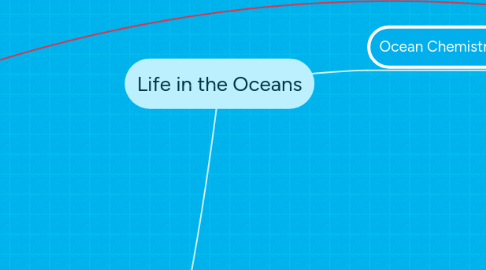
1. Ocean Environments
1.1. Pelagic Zone (open water)
1.1.1. The region of the ocean water above the ocean floor.
1.1.2. There are two zones involving distance from shore.
1.1.2.1. Neritic Zone
1.1.2.1.1. The zone above the continental shelf.
1.1.2.1.2. Receives abundant sunlight, moderate temperatures, and relatively low water pressure, which are ideal factors for marine life.
1.1.2.1.3. Nekton fill this zone's waters and are a source of much of the seafood we eat.
1.1.2.2. The epipelagic zone is the only zone of depth in the neritic zone.
1.1.2.3. Oceanic Zone
1.1.2.3.1. The zone beyond the continental shelf and consists of deep waters.
1.1.3. There are four zones involving depth.
1.1.3.1. Epipelagic zone
1.1.3.1.1. This is the surface water, and is well sunlit and populated by marine life such as dolphins and fish.
1.1.3.2. Mesopelagic zone
1.1.3.3. Bathypelagic zone
1.1.3.4. Abyssopelagic zone
1.2. Benthic Zone (ocean floor)
1.2.1. Intertidal Zone
1.2.1.1. This is the shallowest benthic zone.
1.2.1.2. The constantly shifting tides and waves make this a continually changing environment for the marine organisms flourishing there.
1.2.2. Sublittoral Zone
1.2.2.1. This is the area of shallow water that is constantly submerged despite shifting waves.
1.2.2.2. Most benthos organisms live in this zone.
1.2.2.2.1. Ex: Sea stars, brittle stars, and sea lilies.
1.2.3. Bathyal Zone
1.2.3.1. It begins at the continental slope and extends to a depth of 4000m.
1.2.3.2. Because little or no sunlight reaches this area, plant life is scarce.
1.2.3.3. Animals that live in this region include octopuses, sea stars, and brachiopods.
1.2.4. Abyssal Zone
1.2.4.1. This is the region of the ocean floor at the abyssal plains.
1.2.4.2. No sunlight reaches this area.
1.2.4.3. Extends from 4000m to 6000m.
1.2.4.4. Animals that live in this area include sponges and worms.
1.2.5. Hadal Zone
1.2.5.1. This is the region of the ocean floor at the trenches.
1.2.5.2. Is STILL unexplored.
1.2.5.3. Scientists believe that almost no life should exist in those waters, but we are yet to see.
2. Ocean Chemistry
2.1. Balance
2.1.1. Ocean chemistry is brought about by a balance of dissolved solids & gases that come as a result of the complex interactions between the ocean water and marine organisms, land, and the atmosphere.
2.1.2. Marine Organisms
2.1.2.1. Removing nutrients and gases from the ocean
2.1.2.1.1. Ex: Photosynthetic organisms taking in the CO2 gas present in the ocean.
2.1.2.1.2. Ex: Absorption carbon, hydrogen, oxygen, and sulfur.
2.1.2.2. Return nutrients back to the ocean
2.1.2.2.1. Ex: Photosynthetic organisms expel O2 gas.
2.1.2.2.2. Ex: Decomposition of marine corpses by bacteria, who then release the nutrients back into the water.
2.2. Upwelling
2.2.1. The distribution of life in the ocean depends on the way nutrients are distributed (i.e., animals go where the food is).
2.2.1.1. Accordingly, most life is present in surface water.
2.2.2. The nutrients present at the surface eventually drop to the ocean floor (esp. when animals die, sink, and decompose). Hence, the ocean floor acts as a storage for minerals & nutrients.
2.2.3. The nutrients are brought back to the surface by processes such as upwelling.
2.2.3.1. Upwelling is the movement of deep, cold, and nutrient-rich water to the surface.
2.2.3.1.1. When wind blows steadily parallel to a coastline, surface water moves farther offshore.
2.2.3.1.2. Deep water then rises to replace that surface water.
2.2.3.1.3. It may also occur due to ocean currents.
2.3. Marine Food Webs
2.3.1. Because most marine organisms require sunlight and nutrition to survive, most of them live in surface water (as stated in how life distribution depends on nutrient distribution).
2.3.1.1. The fundamental organism of the marine food web is the plankton - a free-floating, microscopic plant or animal.
2.3.1.1.1. Plankton are usually consumed by small marine organisms, who in turn are consumed by larger marine organisms, and so on.
2.3.1.2. Larger marine organisms fall into one of two categories.
2.3.1.2.1. Nektons Organisms that swim actively in open water.
2.3.1.2.2. Benthos Organisms that live on the ocean floor.
2.4. Balance
2.4.1. The chemistry of the ocean is a result of the balance of dissolved gases and solids, brought about by the interaction of the ocean with its marine organisms, land, and the atmosphere.
2.4.2. Marine Organisms
2.4.2.1. Removing nutrients and gases from the ocean
2.4.2.2. Returning other nutrients and gases back to the ocean.
2.4.2.2.1. Photosynthetic marine plants release oxygen into the ocean water.
